

Compact Muon Solenoid
LHC, CERN
| CMS-PAS-EXO-16-013 | ||
| Search for dark matter production in association with jets, or hadronically decaying W or Z boson at $\sqrt{s} = $ 13 TeV | ||
| CMS Collaboration | ||
| April 2016 | ||
| Abstract: A search for new physics is performed using events with large missing transverse momentum and one or more jets with high transverse momenta in a data sample of proton-proton interactions at the centre-of-mass energy of 13 TeV collected with the CMS detector at the LHC in 2015. This includes a dedicated search for new physics in events in which a hadronically decaying W or Z boson is produced in association with large missing transverse energy. The data correspond to an integrated luminosity of 2.3 fb$^{-1}$. Results are presented in terms of limits on the dark matter production in association with jets and vector bosons using simplified models, and on the decay of the standard model Higgs boson to invisible particles. Vector and axial-vector mediators with masses up to 1.3 TeV are excluded at a 90% confidence level. The expected and observed upper limits on the invisible branching fraction of the standard model Higgs boson are found to be 0.84 and 0.85, respectively, at a 95% confidence level. | ||
| Links: CDS record (PDF) ; inSPIRE record ; CADI line (restricted) ; | ||
| Figures | |

png pdf |
Figure 1-a:
Monojet production diagram for spin-1 mediator. |
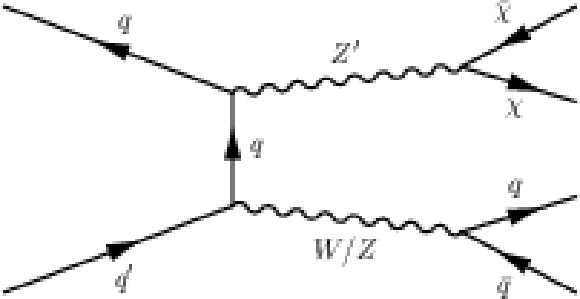
png pdf |
Figure 1-b:
Mono-V production diagram for spin-1 mediator. |

png pdf |
Figure 2-a:
Comparison between data and Monte Carlo simulation in the dimuon control region before and after performing the simultaneous fit across all the control regions and the signal region. Plot (a) corresponds to the monojet category and plot (b) corresponds to the mono-V category. The orange histogram corresponds to all processes other than Z+jets. The gray band indicates the postfit uncertainty after propagating all the systematic uncertainties to the fit. The last bin includes all events with ${E_{\mathrm {T}}^{\text {miss}}} > $ 1160 GeV in the monojet category and ${E_{\mathrm {T}}^{\text {miss}}} > $ 750 GeV in the mono-V category. |
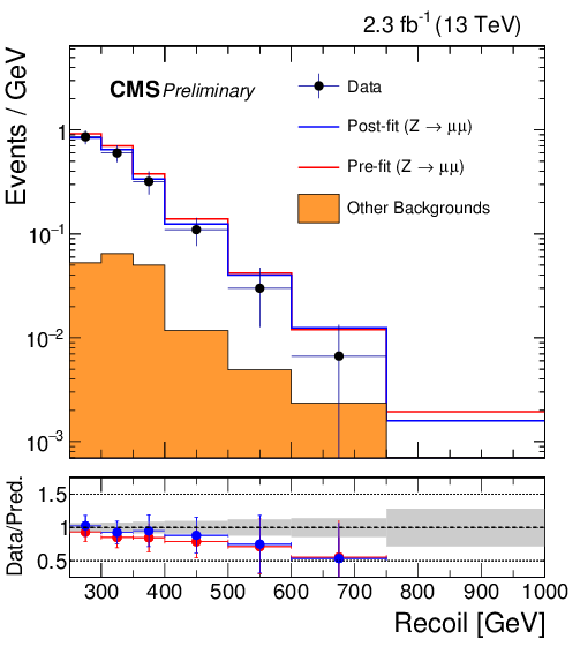
png pdf |
Figure 2-b:
Comparison between data and Monte Carlo simulation in the dimuon control region before and after performing the simultaneous fit across all the control regions and the signal region. Plot (a) corresponds to the monojet category and plot (b) corresponds to the mono-V category. The orange histogram corresponds to all processes other than Z+jets. The gray band indicates the postfit uncertainty after propagating all the systematic uncertainties to the fit. The last bin includes all events with ${E_{\mathrm {T}}^{\text {miss}}} > $ 1160 GeV in the monojet category and ${E_{\mathrm {T}}^{\text {miss}}} > $ 750 GeV in the mono-V category. |
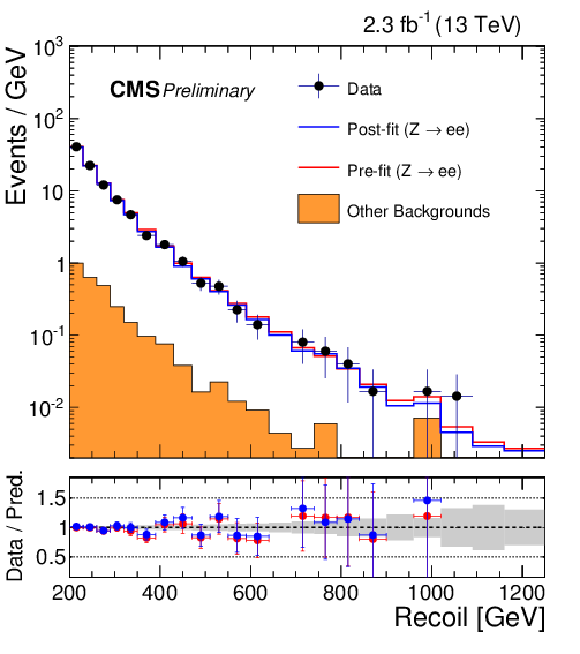
png pdf |
Figure 3-a:
Comparison between data and Monte Carlo simulation in the dielectron control region before and after performing the simultaneous fit across all the control regions and the signal region. Plot (a) corresponds to the monojet category and plot (b) corresponds to the mono-V category. The orange histogram corresponds to all processes other than Z+jets. The gray band indicates the post-fit uncertainty after propagating all the systematic uncertainties to the fit. The last bin includes all events with ${E_{\mathrm {T}}^{\text {miss}}} > $ 1160 GeV in the monojet category and ${E_{\mathrm {T}}^{\text {miss}}} > $ 750 GeV in the mono-V category. |
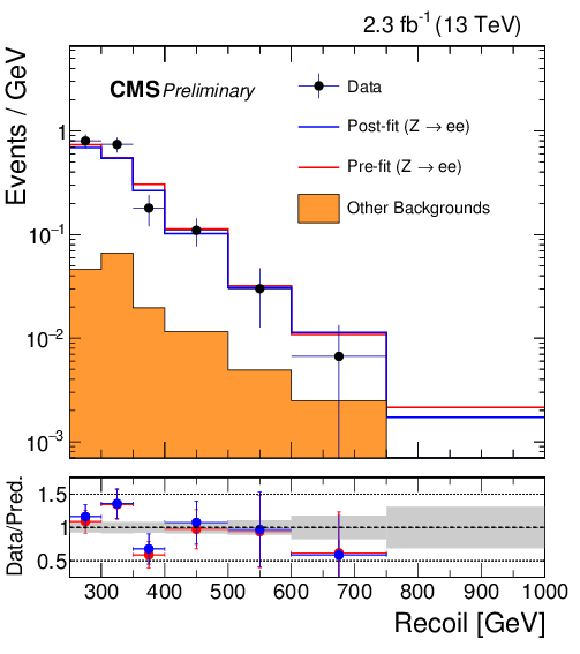
png pdf |
Figure 3-b:
Comparison between data and Monte Carlo simulation in the dielectron control region before and after performing the simultaneous fit across all the control regions and the signal region. Plot (a) corresponds to the monojet category and plot (b) corresponds to the mono-V category. The orange histogram corresponds to all processes other than Z+jets. The gray band indicates the post-fit uncertainty after propagating all the systematic uncertainties to the fit. The last bin includes all events with ${E_{\mathrm {T}}^{\text {miss}}} > $ 1160 GeV in the monojet category and ${E_{\mathrm {T}}^{\text {miss}}} > $ 750 GeV in the mono-V category. |
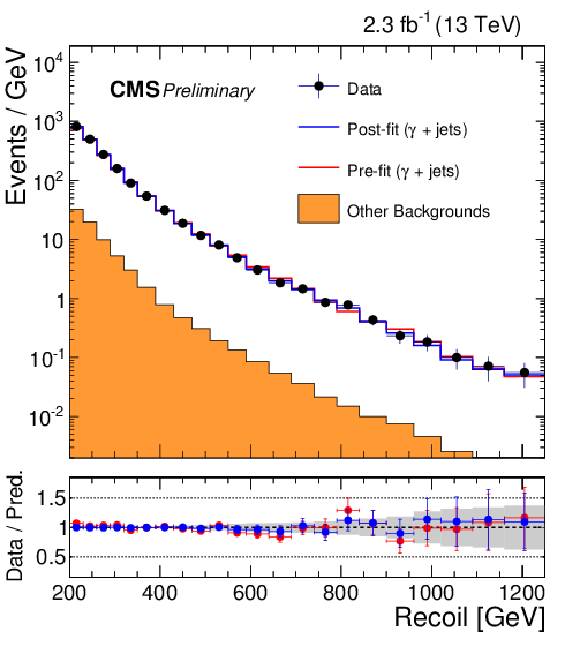
png pdf |
Figure 4-a:
Comparison between data and Monte Carlo simulation in the ${\gamma +\textrm {jets}}$ control region before and after performing the simultaneous fit across all the control regions and the signal region. Plot (a) corresponds to the monojet category and plot (b) corresponds to the mono-V category. The orange histogram corresponds to the QCD background. The gray band indicates the post-fit uncertainty after propagating all the systematic uncertainties to the fit. The last bin includes all events with ${E_{\mathrm {T}}^{\text {miss}}} > $ 1160 GeV in the monojet category and ${E_{\mathrm {T}}^{\text {miss}}} > $ 750 GeV in the mono-V category. |

png pdf |
Figure 4-b:
Comparison between data and Monte Carlo simulation in the ${\gamma +\textrm {jets}}$ control region before and after performing the simultaneous fit across all the control regions and the signal region. Plot (a) corresponds to the monojet category and plot (b) corresponds to the mono-V category. The orange histogram corresponds to the QCD background. The gray band indicates the post-fit uncertainty after propagating all the systematic uncertainties to the fit. The last bin includes all events with ${E_{\mathrm {T}}^{\text {miss}}} > $ 1160 GeV in the monojet category and ${E_{\mathrm {T}}^{\text {miss}}} > $ 750 GeV in the mono-V category. |
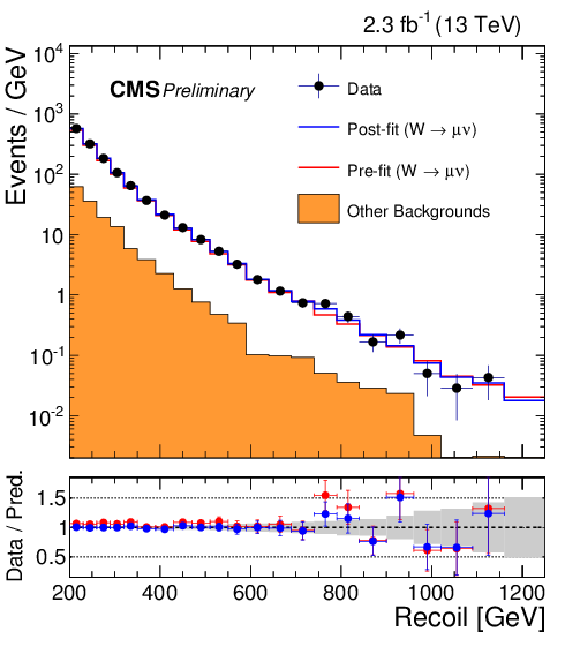
png pdf |
Figure 5-a:
Comparison between data and Monte Carlo simulation in the single-muon control region before and after performing the simultaneous fit across all the control regions and the signal region. Plot (a) corresponds to the monojet category and plot (b) corresponds to the mono-V category. The orange histogram corresponds to all processes other than W+jets. The gray band indicates the post-fit uncertainty after propagating all the systematic uncertainties to the fit. The last bin includes all events with ${E_{\mathrm {T}}^{\text {miss}}} > $ 1160 GeV in the monojet category and ${E_{\mathrm {T}}^{\text {miss}}} > $ 750 GeV in the mono-V category. |

png pdf |
Figure 5-b:
Comparison between data and Monte Carlo simulation in the single-muon control region before and after performing the simultaneous fit across all the control regions and the signal region. Plot (a) corresponds to the monojet category and plot (b) corresponds to the mono-V category. The orange histogram corresponds to all processes other than W+jets. The gray band indicates the post-fit uncertainty after propagating all the systematic uncertainties to the fit. The last bin includes all events with ${E_{\mathrm {T}}^{\text {miss}}} > $ 1160 GeV in the monojet category and ${E_{\mathrm {T}}^{\text {miss}}} > $ 750 GeV in the mono-V category. |
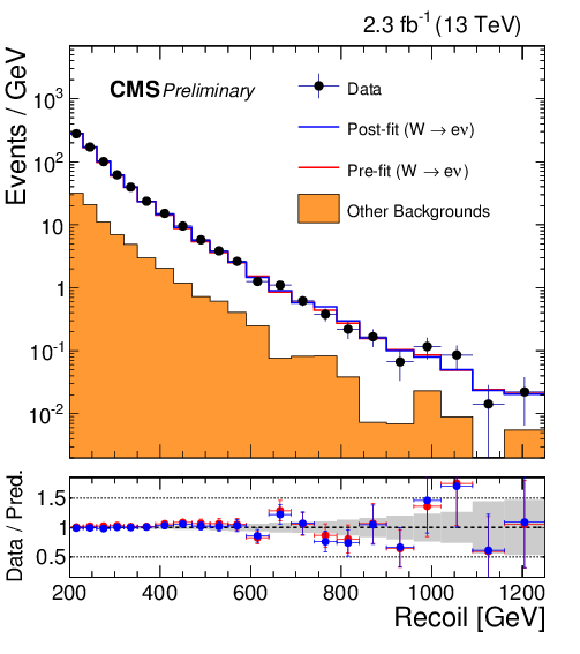
png pdf |
Figure 6-a:
Comparison between data and Monte Carlo simulation in the single-electron control region before and after performing the simultaneous fit across all the control regions and the signal region. Plot (a) corresponds to the monojet category and plot (b) corresponds to the mono-V category. The orange histogram corresponds to all processes other than W+jets. The gray band indicates the post-fit uncertainty after propagating all the systematic uncertainties to the fit. The last bin includes all events with ${E_{\mathrm {T}}^{\text {miss}}} > $ 1160 GeV in the monojet category and ${E_{\mathrm {T}}^{\text {miss}}} > $ 750 GeV in the mono-V category. |
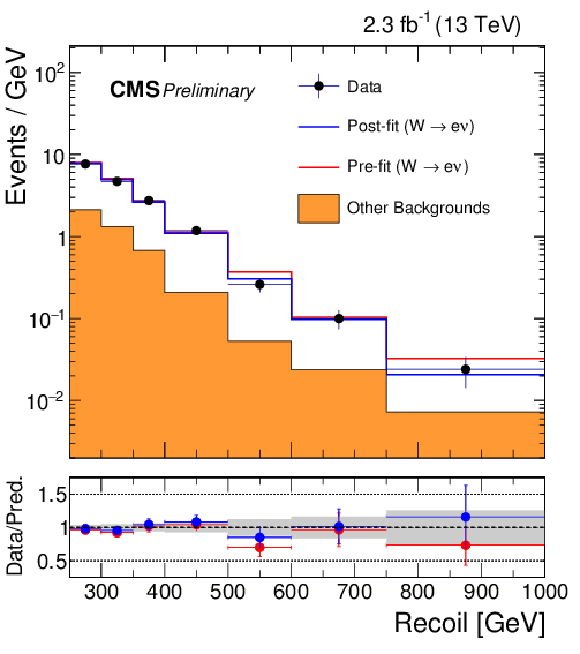
png pdf |
Figure 6-b:
Comparison between data and Monte Carlo simulation in the single-electron control region before and after performing the simultaneous fit across all the control regions and the signal region. Plot (a) corresponds to the monojet category and plot (b) corresponds to the mono-V category. The orange histogram corresponds to all processes other than W+jets. The gray band indicates the post-fit uncertainty after propagating all the systematic uncertainties to the fit. The last bin includes all events with ${E_{\mathrm {T}}^{\text {miss}}} > $ 1160 GeV in the monojet category and ${E_{\mathrm {T}}^{\text {miss}}} > $ 750 GeV in the mono-V category. |
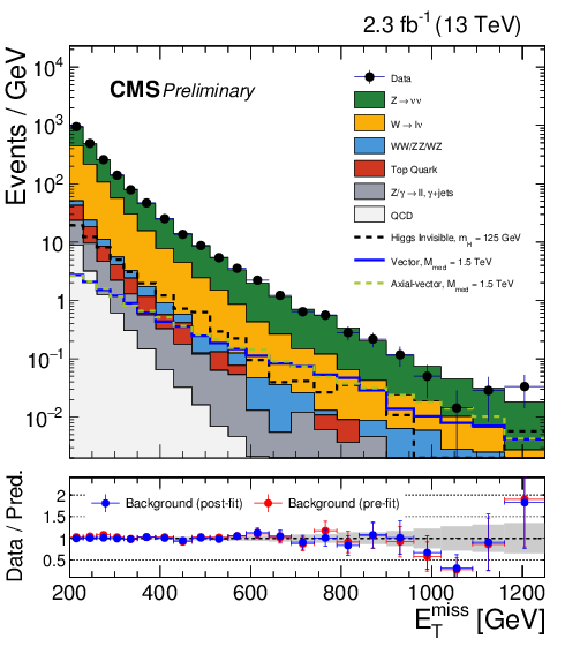
png pdf |
Figure 7-a:
Post-fit distribution of ${E_{\mathrm {T}}^{\text {miss}}}$ expected from SM backgrounds and observed in data in the monojet (a) and mono-V (b) signal regions with the 125 GeV Higgs boson decaying to invisible particles signal along with a vector and axial-vector mediator with 1.5 TeV mass signals are overlayed. The expected distributions are evaluated after fitting to the observed data in the control and signal regions simultaneously. The gray bands indicate the post-fit uncertainty in the background, assuming no signal. The last bin includes all events with ${E_{\mathrm {T}}^{\text {miss}}} > $ 1160 GeV for the monojet category and ${E_{\mathrm {T}}^{\text {miss}}} > $ 750 GeV for the mono-V category. |
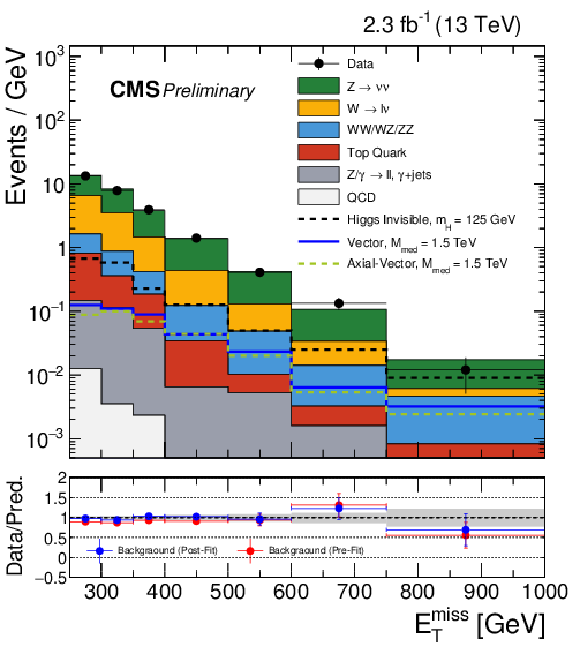
png pdf |
Figure 7-b:
Post-fit distribution of ${E_{\mathrm {T}}^{\text {miss}}}$ expected from SM backgrounds and observed in data in the monojet (a) and mono-V (b) signal regions with the 125 GeV Higgs boson decaying to invisible particles signal along with a vector and axial-vector mediator with 1.5 TeV mass signals are overlayed. The expected distributions are evaluated after fitting to the observed data in the control and signal regions simultaneously. The gray bands indicate the post-fit uncertainty in the background, assuming no signal. The last bin includes all events with ${E_{\mathrm {T}}^{\text {miss}}} > $ 1160 GeV for the monojet category and ${E_{\mathrm {T}}^{\text {miss}}} > $ 750 GeV for the mono-V category. |
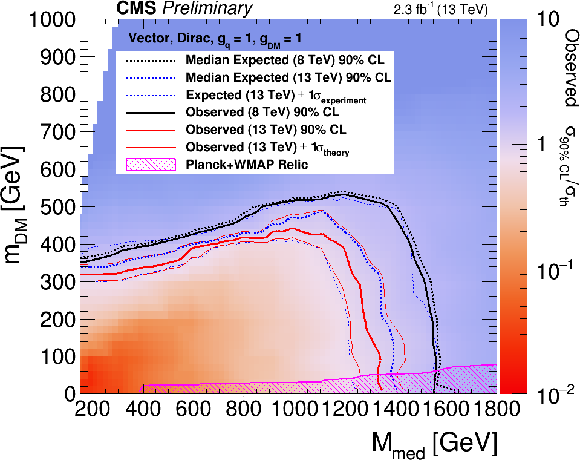
png |
Figure 8-a:
Exclusion limits at a 90% CL on $\mu =\sigma /\sigma _{\textrm {th}}$ in the $m_{\textrm {DM}}$-$m_{\textrm {MED}}$ plane assuming vector (a) and axial-vector (b) mediators. The solid (dotted) red (blue) line shows the contour for the observed (expected) exclusion using 13 TeV data. The solid contours around the observed limit and the dashed contours around the expected limit represent the one standard deviation theoretical uncertainties in the cross section and the combination of the statistical and experimental systematic uncertainties, respectively. The solid (dotted) black line shows the contour for the observed (expected) exclusion using 8 TeV data [7]. Cosmological constraints from the WMAP and Planck experiments [57,58] are shown with the magenta line. |
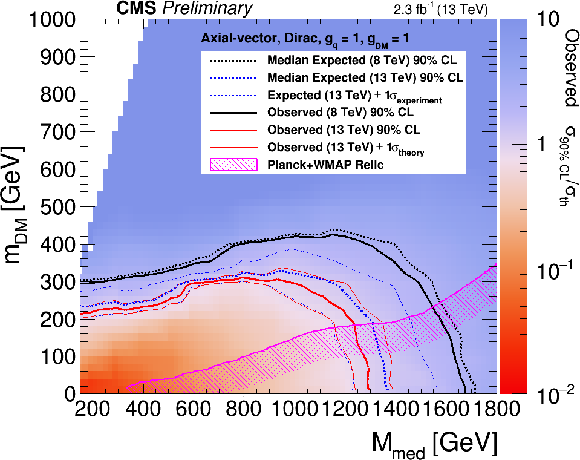
png |
Figure 8-b:
Exclusion limits at a 90% CL on $\mu =\sigma /\sigma _{\textrm {th}}$ in the $m_{\textrm {DM}}$-$m_{\textrm {MED}}$ plane assuming vector (a) and axial-vector (b) mediators. The solid (dotted) red (blue) line shows the contour for the observed (expected) exclusion using 13 TeV data. The solid contours around the observed limit and the dashed contours around the expected limit represent the one standard deviation theoretical uncertainties in the cross section and the combination of the statistical and experimental systematic uncertainties, respectively. The solid (dotted) black line shows the contour for the observed (expected) exclusion using 8 TeV data [7]. Cosmological constraints from the WMAP and Planck experiments [57,58] are shown with the magenta line. |
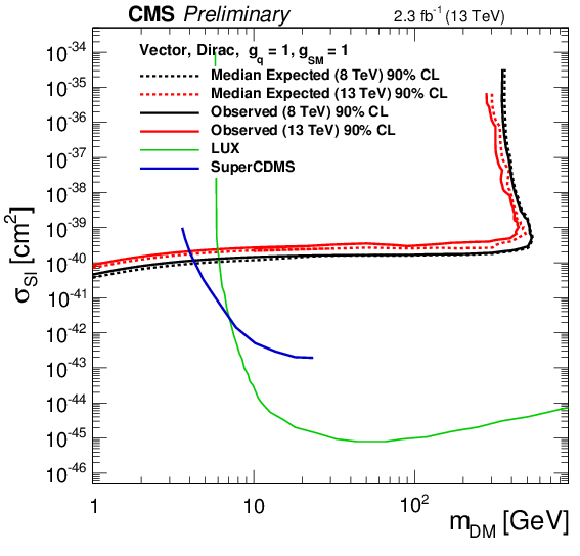
png pdf |
Figure 9-a:
Exclusion limits at a 90% CL in the $m_{\textrm {DM}}$-$\sigma _{\textrm {SI/SD}}$ plane assuming vector (a) and axial-vector (b) mediators. The solid (dotted) red line shows the contour for the observed (expected) exclusion using 13 TeV data. The solid (dotted) black line shows the contour for the observed (expected) exclusion using 8 TeV data [7]. Limits from the Super-Kamiokande [68], PICO-2L [10], PICO-60 [66] and IceCube [67] experiments are shown for the axial-vector mediator case. Limits from the LUX [65] and Super CDMS [63] experiments are shown for the vector mediator case, whereas limits from the Super Kamiokande [68], PICO [10,66] and IceCube [67] experiments are shown for the axial-vector mediator case. |
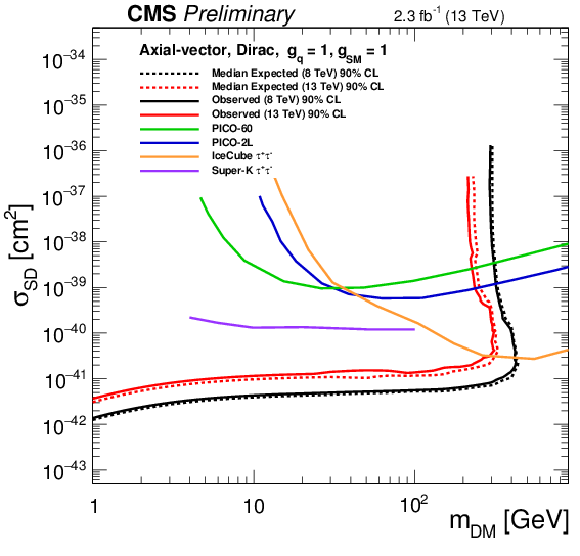
png pdf |
Figure 9-b:
Exclusion limits at a 90% CL in the $m_{\textrm {DM}}$-$\sigma _{\textrm {SI/SD}}$ plane assuming vector (a) and axial-vector (b) mediators. The solid (dotted) red line shows the contour for the observed (expected) exclusion using 13 TeV data. The solid (dotted) black line shows the contour for the observed (expected) exclusion using 8 TeV data [7]. Limits from the Super-Kamiokande [68], PICO-2L [10], PICO-60 [66] and IceCube [67] experiments are shown for the axial-vector mediator case. Limits from the LUX [65] and Super CDMS [63] experiments are shown for the vector mediator case, whereas limits from the Super Kamiokande [68], PICO [10,66] and IceCube [67] experiments are shown for the axial-vector mediator case. |
| Tables | |

png pdf |
Table 1:
Expected and observed 95% CL upper limits on $\sigma \times \textrm {BR}(\textrm {H} \rightarrow \textrm {invisible}) / \sigma _{\textrm {H}}$ for the 125 GeV Higgs boson. Limits are tabulated for the monojet and mono-V categories separately, and also for their combination. The 1$\sigma $ uncertainty range on the expected limits is listed. The signal composition in terms of the gluon fusion, vector boson fusion, and Higgs-strahlung processes is also provided. |
| Summary |
| A search for DM has been performed in the monojet and mono-V final states using 13 TeV proton-proton collision data corresponding to an integrated luminosity of 2.3 fb$^{-1}$. No significant excess is observed with respect to the SM backgrounds. Limits are computed on the DM production cross section using simplified models in which DM production is mediated by spin-1 particles. Vector and axial-vector mediators with masses up to 1.3 TeV are excluded at a 90% CL. The search yields an observed (expected) upper limit of 0.85 (0.84) at a 95% CL on the invisible branching fraction of the 125 GeV Higgs boson assuming SM production cross section. |
| Additional Figures | |

png pdf |
Additional Figure 1:
Distribution of the charged-hadron fraction of the energy of the leading jet in events passing all the monojet selection criteria except for the jet fraction requirements. The beam backgrounds dominate events with the charged-hadron fraction close to zero since the reconstructed jet in these events does not have tracks pointing to the center of the detector. This is reflected in the large disagreement between data and simulation at low values of the charged-hadron fraction. The charged-hadron fraction of the leading jet energy is required to be larger than 0.1. |
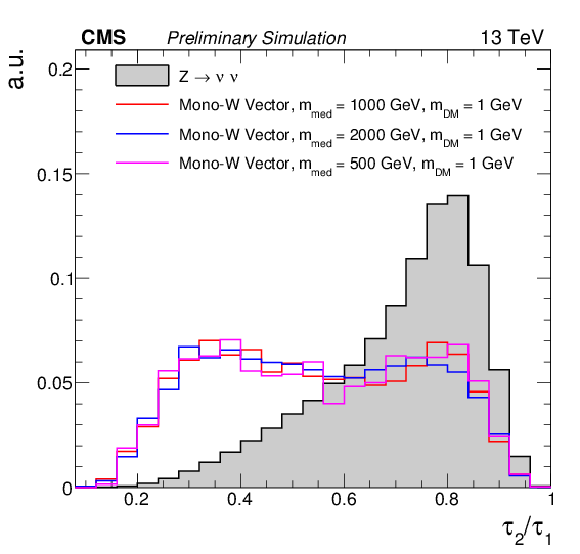
png pdf |
Additional Figure 2-a:
The $\tau _{2}/\tau _{1}$ distribution of the leading AK8 jet in $\textrm {Z}(\nu \nu )$+jets background and mono-W signal events assuming (a) vector and (b) scalar mediator. The leading AK8 jet is required to have $|\eta |< $ 2.4 and $ {p_{\mathrm {T}}} > $ 250 GeV; the ${E_{\mathrm {T}}^{\text {miss}}}$ in the event is required to be larger than 250 GeV. Distributions are normalized to unity. |
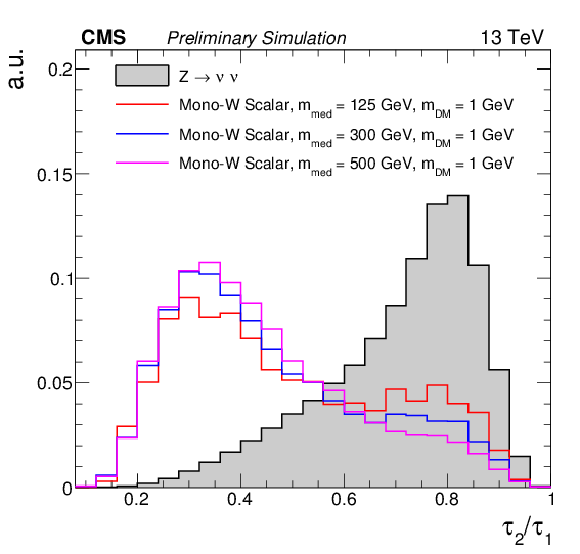
png pdf |
Additional Figure 2-b:
The $\tau _{2}/\tau _{1}$ distribution of the leading AK8 jet in $\textrm {Z}(\nu \nu )$+jets background and mono-W signal events assuming (a) vector and (b) scalar mediator. The leading AK8 jet is required to have $|\eta |< $ 2.4 and $ {p_{\mathrm {T}}} > $ 250 GeV; the ${E_{\mathrm {T}}^{\text {miss}}}$ in the event is required to be larger than 250 GeV. Distributions are normalized to unity. |
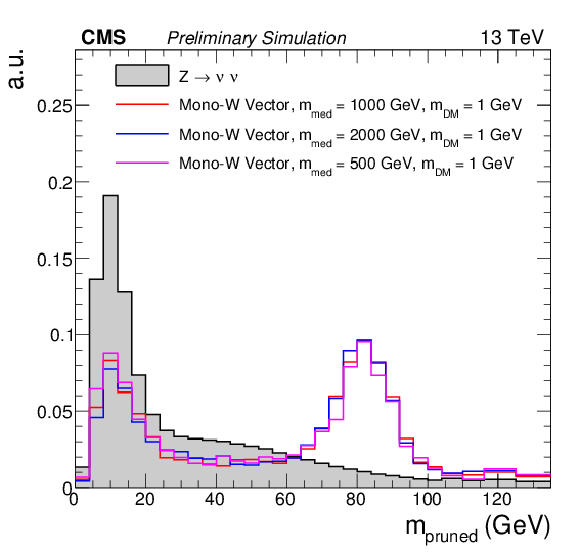
png pdf |
Additional Figure 3-a:
The pruned mass distribution of the leading AK8 jet in $\textrm {Z}(\nu \nu )$+jets background and mono-W signal events assuming (a) vector and (b) scalar mediator. The leading AK8 jet is required to have $|\eta |< $ 2.4 and $ {p_{\mathrm {T}}} > $ 250 GeV; the ${E_{\mathrm {T}}^{\text {miss}}}$ in the event is required to be larger than 250 GeV. Distributions are normalized to unity. |
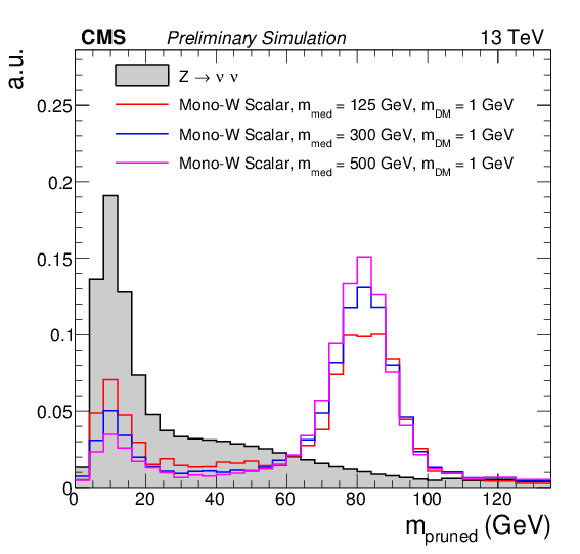
png pdf |
Additional Figure 3-b:
The pruned mass distribution of the leading AK8 jet in $\textrm {Z}(\nu \nu )$+jets background and mono-W signal events assuming (a) vector and (b) scalar mediator. The leading AK8 jet is required to have $|\eta |< $ 2.4 and $ {p_{\mathrm {T}}} > $ 250 GeV; the ${E_{\mathrm {T}}^{\text {miss}}}$ in the event is required to be larger than 250 GeV. Distributions are normalized to unity. |
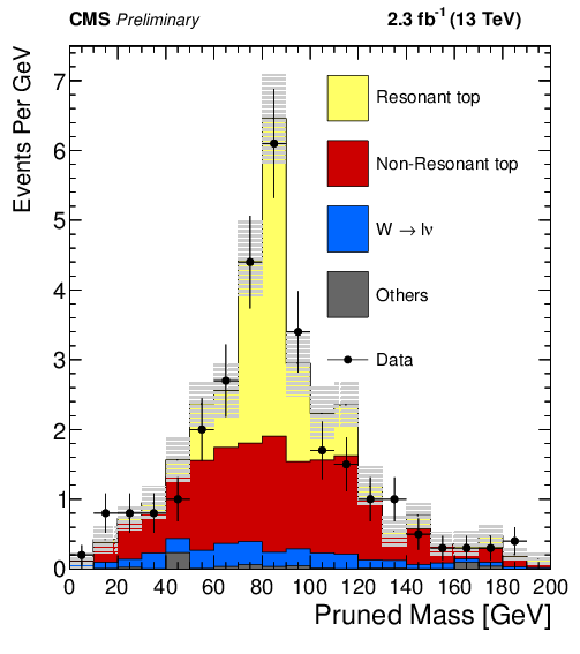
png pdf |
Additional Figure 4-a:
The pruned mass of the leading AK8 jet in a sample of top quark enriched events. Events are required to have two b-tagged jets and one well-identified lepton. The leading AK8 jet is required to have $|\eta |< $ 2.4 and ${p_{\mathrm {T}}} > $ 250 GeV. The hadronic recoil in the event is required to be larger than 250 GeV. The resonant top quark contribution corresponds to top quark events in simulation wherein the leading AK8 jet is matched to the hadronic decay of a W boson. Similarly, the non-resonant top quark contribution corresponds to top quark events in simulation wherein the leading AK8 jet cannot be matched to the hadronic decay of a W boson. The pruned mass distribution is shown with (a) no requirement on the $\tau _{2}/\tau _{1}$ variable; (b) $\tau _{2}/\tau _{1} > $ 0.6 . The grey band indicates the statistical uncertainty on the simulated event sample. |
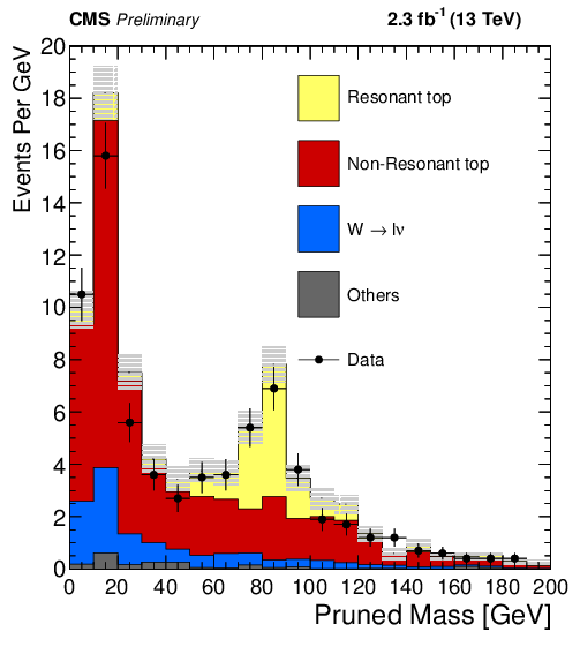
png pdf |
Additional Figure 4-b:
The pruned mass of the leading AK8 jet in a sample of top quark enriched events. Events are required to have two b-tagged jets and one well-identified lepton. The leading AK8 jet is required to have $|\eta |< $ 2.4 and ${p_{\mathrm {T}}} > $ 250 GeV. The hadronic recoil in the event is required to be larger than 250 GeV. The resonant top quark contribution corresponds to top quark events in simulation wherein the leading AK8 jet is matched to the hadronic decay of a W boson. Similarly, the non-resonant top quark contribution corresponds to top quark events in simulation wherein the leading AK8 jet cannot be matched to the hadronic decay of a W boson. The pruned mass distribution is shown with (a) no requirement on the $\tau _{2}/\tau _{1}$ variable; (b) $\tau _{2}/\tau _{1} > $ 0.6 . The grey band indicates the statistical uncertainty on the simulated event sample. |

png pdf |
Additional Figure 5-a:
The $\tau _{2}/\tau _{1}$ distribution of the leading AK8 jet in a sample of top quark enriched events. Events are required to have two b-tagged jets and one well-identified lepton. The leading AK8 jet is required to have $|\eta |< $ 2.4 and ${p_{\mathrm {T}}} > $ 250 GeV. The hadronic recoil in the event is required to be larger than 250 GeV. The resonant top quark contribution corresponds to top quark events in simulation wherein the leading AK8 jet is matched to the hadronic decay of a W boson. Similarly, the non-resonant top quark contribution corresponds to top quark events in simulation wherein the leading AK8 jet cannot be matched to the hadronic decay of a W boson. The $\tau _{2}/\tau _{1}$ distribution is shown with (a) no requirement on the pruned mass of the leading AK8 jet; (b) the pruned mass of the leading AK8 jet within 65 GeV and 105 GeV. The grey band indicates the statistical uncertainty on the simulated event sample. |
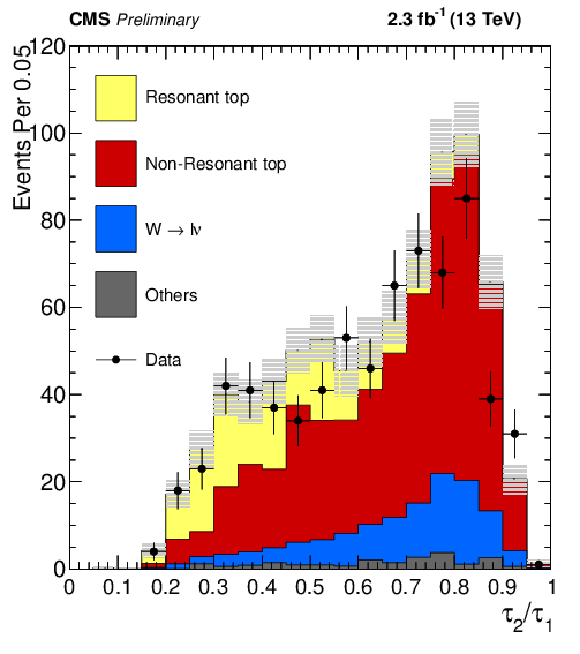
png pdf |
Additional Figure 5-b:
The $\tau _{2}/\tau _{1}$ distribution of the leading AK8 jet in a sample of top quark enriched events. Events are required to have two b-tagged jets and one well-identified lepton. The leading AK8 jet is required to have $|\eta |< $ 2.4 and ${p_{\mathrm {T}}} > $ 250 GeV. The hadronic recoil in the event is required to be larger than 250 GeV. The resonant top quark contribution corresponds to top quark events in simulation wherein the leading AK8 jet is matched to the hadronic decay of a W boson. Similarly, the non-resonant top quark contribution corresponds to top quark events in simulation wherein the leading AK8 jet cannot be matched to the hadronic decay of a W boson. The $\tau _{2}/\tau _{1}$ distribution is shown with (a) no requirement on the pruned mass of the leading AK8 jet; (b) the pruned mass of the leading AK8 jet within 65 GeV and 105 GeV. The grey band indicates the statistical uncertainty on the simulated event sample. |

png pdf |
Additional Figure 6-a:
Event displays showing the $\rho -\phi $ view of events passing the monojet selection (a) and the mono-V selection (b). Event shown in (a) is also the highest ${E_{\mathrm {T}}^{\text {miss}}}$ event included in the analysis. |
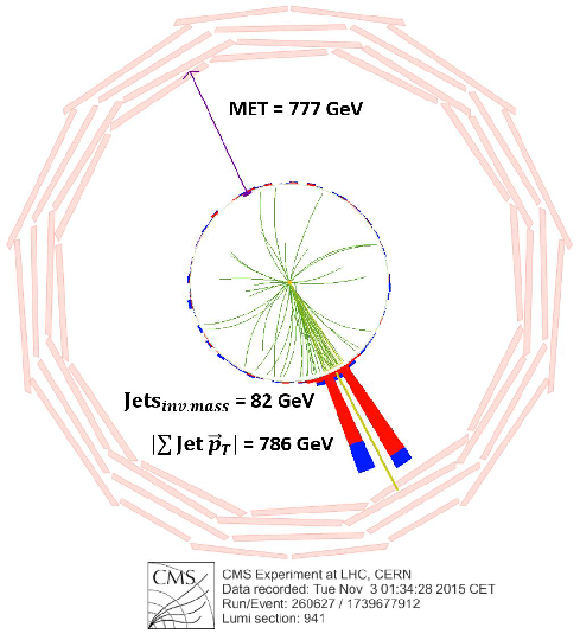
png pdf |
Additional Figure 6-b:
Event displays showing the $\rho -\phi $ view of events passing the monojet selection (a) and the mono-V selection (b). Event shown in (a) is also the highest ${E_{\mathrm {T}}^{\text {miss}}}$ event included in the analysis. |
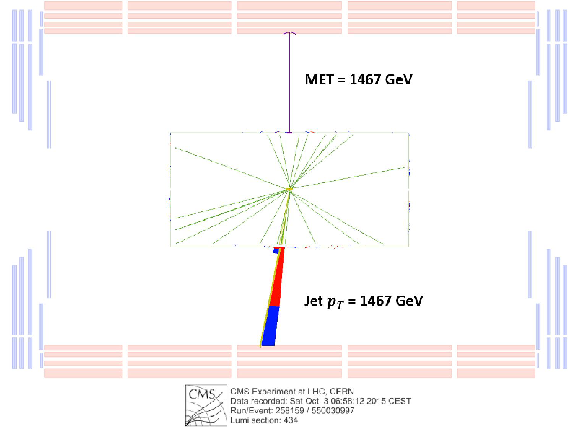
png pdf |
Additional Figure 7-a:
Event displays showing the $\rho -z$ view of events passing the monojet selection (a) and the mono-V selection (b). Event shown in (a) is also the highest ${E_{\mathrm {T}}^{\text {miss}}}$ event included in the analysis. |

png pdf |
Additional Figure 7-b:
Event displays showing the $\rho -z$ view of events passing the monojet selection (a) and the mono-V selection (b). Event shown in (a) is also the highest ${E_{\mathrm {T}}^{\text {miss}}}$ event included in the analysis. |
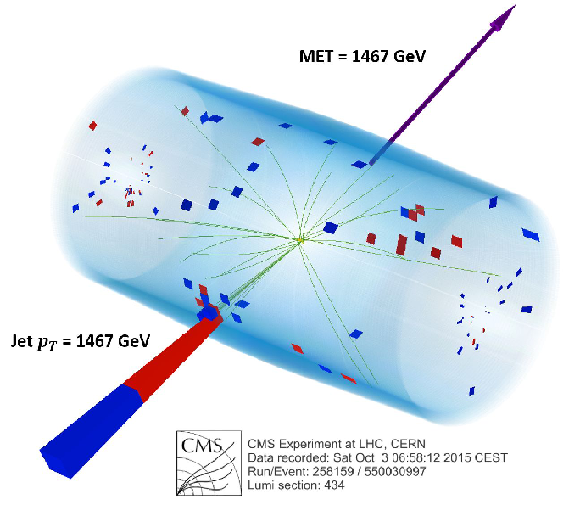
png pdf |
Additional Figure 8-a:
Event displays showing the three-dimensional view of events passing the monojet selection (a) and the mono-V selection (b). Event shown in (a) is also the highest ${E_{\mathrm {T}}^{\text {miss}}}$ event included in the analysis. |
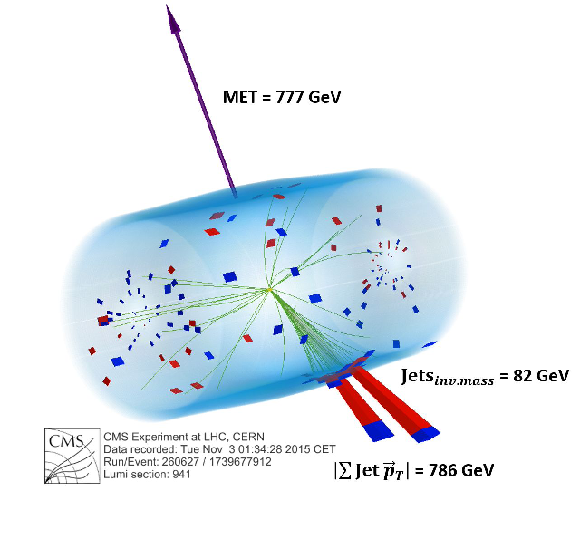
png pdf |
Additional Figure 8-b:
Event displays showing the three-dimensional view of events passing the monojet selection (a) and the mono-V selection (b). Event shown in (a) is also the highest ${E_{\mathrm {T}}^{\text {miss}}}$ event included in the analysis. |
| Additional Tables | |
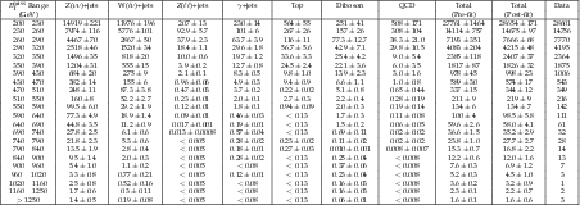
png pdf |
Additional Table 1:
Events yields in the monojet category. The yields of the various processes and the corresponding uncertainties are obtained after performing a combined fit of the signal and the control regions. The fit is performed assuming no signal. |

png pdf |
Additional Table 2:
Events yields in the mono-V category. The yields of the various processes and the corresponding uncertainties are obtained after performing a combined fit of the signal and the control regions. The fit is performed assuming no signal. |

|
Compact Muon Solenoid LHC, CERN |

|

|

|

|

|

|